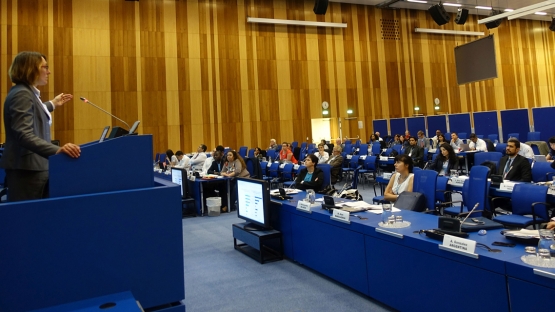Am I safe? Can my children drink the milk? When can I return to my home? During a nuclear or radiological emergency, emergency responders, especially those responsible for public information, face such questions from the public, and many more. Creating international guidance on how to communicate important information to the public to support an effective emergency response is the focus of a Technical Meeting taking place this week in Vienna.
Ultimately, the goal of any public communication during an emergency is to contribute to the protection of people. Well-planned and properly resourced communications arrangements can help people understand and comply with protective actions. The public's fear and perception of their personal risk can hamper informed decision-making. Lessons learned from previous emergencies, such as the Fukushima Daiichi accident, have continually highlighted the need for effective public communication.
69 experts from 48 countries and 5 International Organizations convene at the IAEA headquarters for the full week to further drive the development of the first IAEA safety standards document specifically focusing on public communications in nuclear and radiological emergencies. It is meant to provide international best practice and recommendations in this area.
Ms. Lynn Hubbard, Chair of the Technical Meeting, said that in bringing together so many experts, the meeting will give a varied perspective on the national public communications arrangements being employed throughout the world. "Experience has demonstrated the challenges involved in communicating with the public during nuclear or radiological emergencies. Past emergencies have had local, national, regional and international consequences which have heightened and expanded public awareness and concerns. This meeting will give us an opportunity to learn from the different approaches used to communicate to the public and we can bring this shared knowledge into developing the first draft of the safety guide".
Adapting to any emergency
The safety guide will apply to nuclear and radiological emergencies regardless of whether they arise from accident, negligence or deliberate act. It will give direction on how to adapt public communication in line with the level of response required for any emergency. Participants from several Member States will be delivering presentations on the methods used in their home country and the internal arrangements they have developed to coordinate the public communication actions with response requirements.
"Effective public communication in any response is contingent on the level of preparedness of the Member State and organizations involved, which must be based on strong internal coordination", said Kaisa Raitio, Head of Communications at the Radiation and Nuclear Safety Authority in Finland. She added that, "As a Public Information Officer, it is imperative that I coordinate with the relevant response personnel of the emergency command and control structure in order to ensure that a consistent message is delivered to the public".
Coordination is just one element addressed in the safety guide. Throughout the week, participants will also discuss guidance on developing a communications plan, planning for resource requirements and how to use easily understandable and factual language.
The Technical Meeting is just one part of the development of the safety guide. With the input of the Member States, the draft will be finalised in the coming months and then undergoes an intense vetting process by various committees and the Member States before it will be officially issued as an IAEA Safety Standards Publication and become international guidance.
Experience has demonstrated the challenges involved in communicating with the public during nuclear or radiological emergencies.






